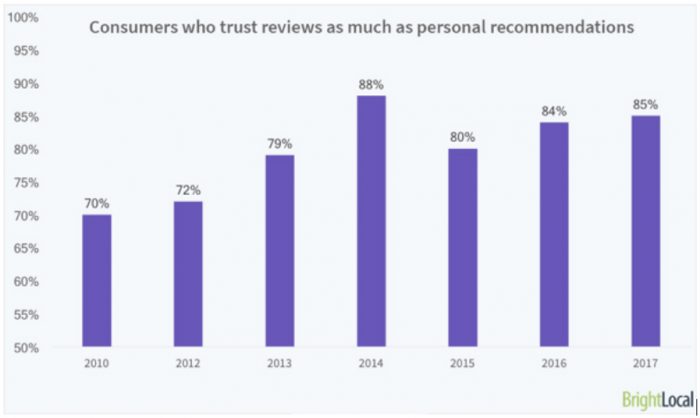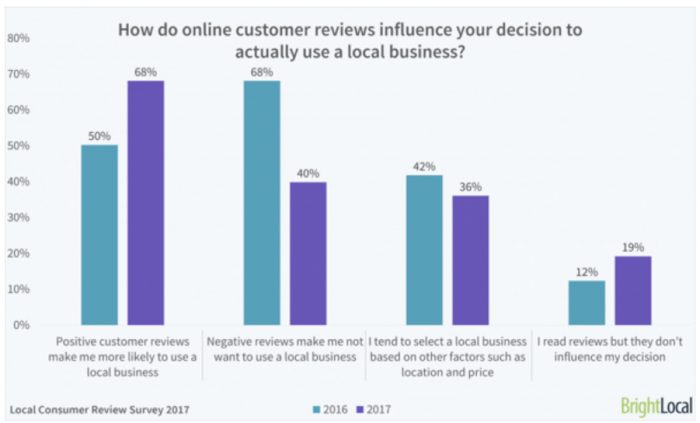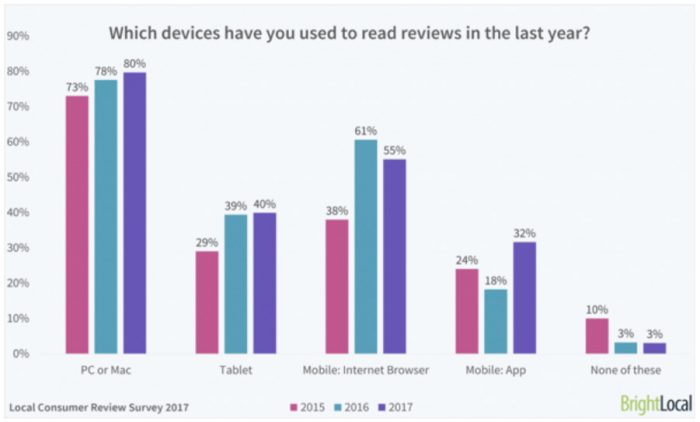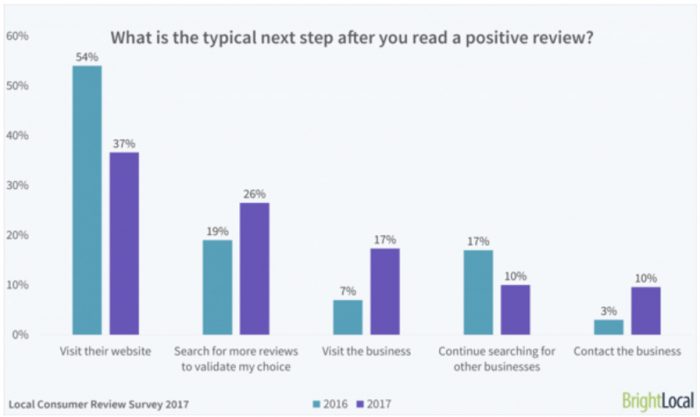Testimonials, opinions, social proof – call them what you will, but consumer reviews are on the up when it comes to what influences a business’s potential customers. Whether fake or fair, people are reading and acting on these online reviews. Here’s a careful look at the latest trends and how consumer trust is measuring up:
For six consecutive years, BrightLocal’s Local Consumer Review Survey has picked the brains of US consumers to gauge their feelings and actions around online business reviews. 2017’s survey, based on the views of a representative sample of more than 1,000 US-based consumers, aims to inform marketers (and, indeed, the wider public) of the trends in review writing, consumption, trust and, for the first time, reaction to fake reviews.
Here, I’ll take a look at some of the biggest trends in online review habits uncovered by the survey, published November 2017. It’s key to note that this survey covers what people say they do and feel, rather than capturing their actual actions, which is also something definitely worth mining.
Consumer trust in reviews is at an (almost) all-time high

Even though 79% of consumers said they’d read a fake review in the past year, overall trust in reviews is still on the up and up. Omitting the anomalous (but no less valid) results of 2014, we’re seeing a steady and almost consistent growth, strongly suggesting that the opinions of complete strangers are on their way to being considered wholly reliable sources.
Couple this with data from Local SEO Guide’s 2017 Local SEO Ranking Factors report, which puts the influence of reviews only below organic rankings, and we’re left with a picture in which the importance of reviews is perhaps just building up steam.
Consumer reviews have, of course, always been important to businesses providing a service that’s used regularly, such as restaurants and hotels, but with the proliferation of niche review sites that cater to everything from medical practitioners to legal services, even professional industries once deemed above the opinions of the masses have been brought into the fold of online reviews.
This should come as no surprise, though: consider the amount of time taken to weigh up where to drink a coffee and where to turn for legal advice — the latter requires far more hunting for testimonials and social proof.
The number of people turned off by negative consumer reviews has dropped significantly

Note: For this question, respondents were allowed to select a maximum of two answers.
In a surprising trend, especially when considering that trust in reviews is at an almost record high, fewer than half the consumers surveyed this year said: “Negative reviews make me not want to use a local business,” while far more admitted that positive reviews make them more likely to use a local business.
This perhaps is reflected in a cultural shift towards scepticism around the negative opinions of others. As more arguments erupt across social media every day, with extremes of opinion more prevalent and any grey areas all but erased, do consumers now find it easier to believe people who are positive than those who are negative?
There has also been a growth in independence of opinion, with 19% of those surveyed saying they read reviews, but don’t let them affect their purchase decisions. One must wonder why nearly a fifth of consumers are reading reviews in the first place, but crucially, we need to also acknowledge how the subconscious plays into this. They say reviews don’t affect their decision, but how can they be absolutely sure?
More people are reading consumer reviews in-app than before

The largest growth in devices used to access consumer reviews has been seen in mobile apps, which certainly suggests that both greater awareness and wider availability of review apps are having an effect on review consumption. Businesses would be wise to concentrate primary reputation-building efforts on those review platforms with a dedicated app.
That said, it’s certainly also interesting to note that year-on-year, more and more people are using their desktop devices to find reviews. With the ever-pervasive growth of mobile search, this is a highly unexpected shift to see. This could speak to how more readily available reviews now are, across a multitude of devices and in multiple outputs (eg. Google My Business).
What happens after reading a positive consumer review:

Bad news for websites, but great news for businesses, as 17% more consumers are choosing to visit or contact the business directly after reading a positive review.
This could be down to an erosion in the time people are willing to spend on finding a local business or a boom in things like Google My Business providing the consumer with all the information they’d get from a website anyway (plus all the social proof found in reviews). Either way, businesses should be very aware that a lot of potential customers are making their decisions without the help of a business website.
Also, with 7% more consumers reading more reviews but 7% fewer looking for other businesses, the average consumer journey now seems to involve comparatively little shopping around. Instead, people are spending more time reading through a single review profile in order to validate their decision. This alludes to less time being spent on websites and more time being spent trawling off-site reviews.
Consumers are expecting higher average star ratings than ever before
With the growth of local businesses’ presence in search ranking, has come a growth in visibility of local business reviews. And as the pool of businesses to choose from in any given local search expands, so too does the average consumer’s expectations.
Here we’re seeing continuous drops in the number of people satisfied with low-to-average (1 to 3-star) scores, but a significant growth in those who expect at least four stars. With 54% citing average star rating as the most important factor in a review profile, this is a warning shot to businesses that think that average is good enough.
Today, with local business so competitive and Google’s local pack containing a measly three results, it’s more critical than ever to ensure your reputation is solid, that your average star rating is, well, above average, and that you’re delivering your absolute best service to every customer.
After all, although it’s not nice to think, it’s important to remember: collectively, your customer base has the potential to hold your reputation to ransom.
Have an opinion on this article? Please join in the discussion: the GMA is a community of data driven marketers and YOUR opinion counts.









Leave your thoughts